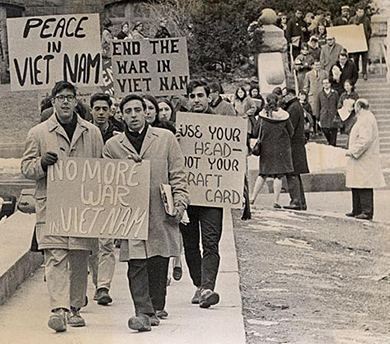| << Chapter < Page | Chapter >> Page > |
Read the full text of the Port Huron Statement by Tom Hayden.
SDS members demanded that universities allow more student participation in university governance and shed their entanglements with the military-industrial complex. They sought to rouse the poor to political action to defeat poverty and racism. In the summer of 1964, a small group of SDS members moved into the uptown district of Chicago and tried to take on racism and poverty through community organization. Under the umbrella of their Economic Research and Action Project, they created JOIN (Jobs or Income Now) to address problems of urban poverty and resisted plans to displace the poor under the guise of urban renewal. They also called for police review boards to end police brutality, organized free breakfast programs, and started social and recreational clubs for neighborhood youth. Eventually, the movement fissured over whether to remain a campus-based student organization or a community-based development organization.
During the same time that SDS became active in Chicago, another student movement emerged on the West Coast, when actions by student activists at the University of California, Berkeley, led to the formation of Berkeley’s Free Speech Movement in 1964. University rules prohibited the solicitation of funds for political causes by anyone other than members of the student Democratic and Republican organizations, and restricted advocacy of political causes on campus. In October 1964, when a student handing out literature for CORE refused to show campus police officers his student ID card, he was promptly arrested. Instantly, the campus police car was surrounded by angry students, who refused to let the vehicle move for thirty-two hours until the student was released. In December, students organized a massive sit-in to resolve the issue of political activities on campus. While unsuccessful in the short term, the movement inspired student activism on campuses throughout the country.
A target of many student groups was the war in Vietnam ( [link] ). In April 1965, SDS organized a march on Washington for peace; about twenty thousand people attended. That same week, the faculty at the University of Michigan suspended classes and conducted a 24-hour “teach-in” on the war. The idea quickly spread, and on May 15, the first national “teach-in” was held at 122 colleges and universities across the nation. Originally designed to be a debate on the pros and cons of the war, at Berkeley, the teach-ins became massive antiwar rallies. By the end of that year, there had been antiwar rallies in some sixty cities.

Overwhelmingly, young cultural warriors and social activists of the 1960s, trying to escape the shackles of what they perceived to be limits on their freedoms, adopted blue jeans as the uniform of their generation. Originally worn by manual laborers because of their near-indestructibility, blue jeans were commonly associated with cowboys, the quintessential icon of American independence. During the 1930s, jeans were adopted by a broader customer base as a result of the popularity of cowboy movies and dude ranch vacations. After World War II, Levi Strauss, their original manufacturer, began to market them east of the Mississippi, and competitors such as Wrangler and Lee fought for a share of the market. In the 1950s, youths testing the limits of middle-class conformity adopted them in imitation of movie stars like James Dean. By the 1960s, jeans became even more closely associated with youthful rebellion against tradition, a symbol available to everyone, rich and poor, black and white, men and women.
What other styles and behaviors of the 1960s expressed nonconformity, and how?

Notification Switch
Would you like to follow the 'U.s. history' conversation and receive update notifications?